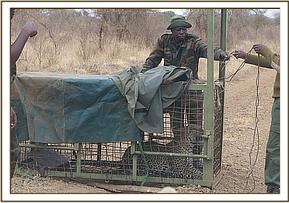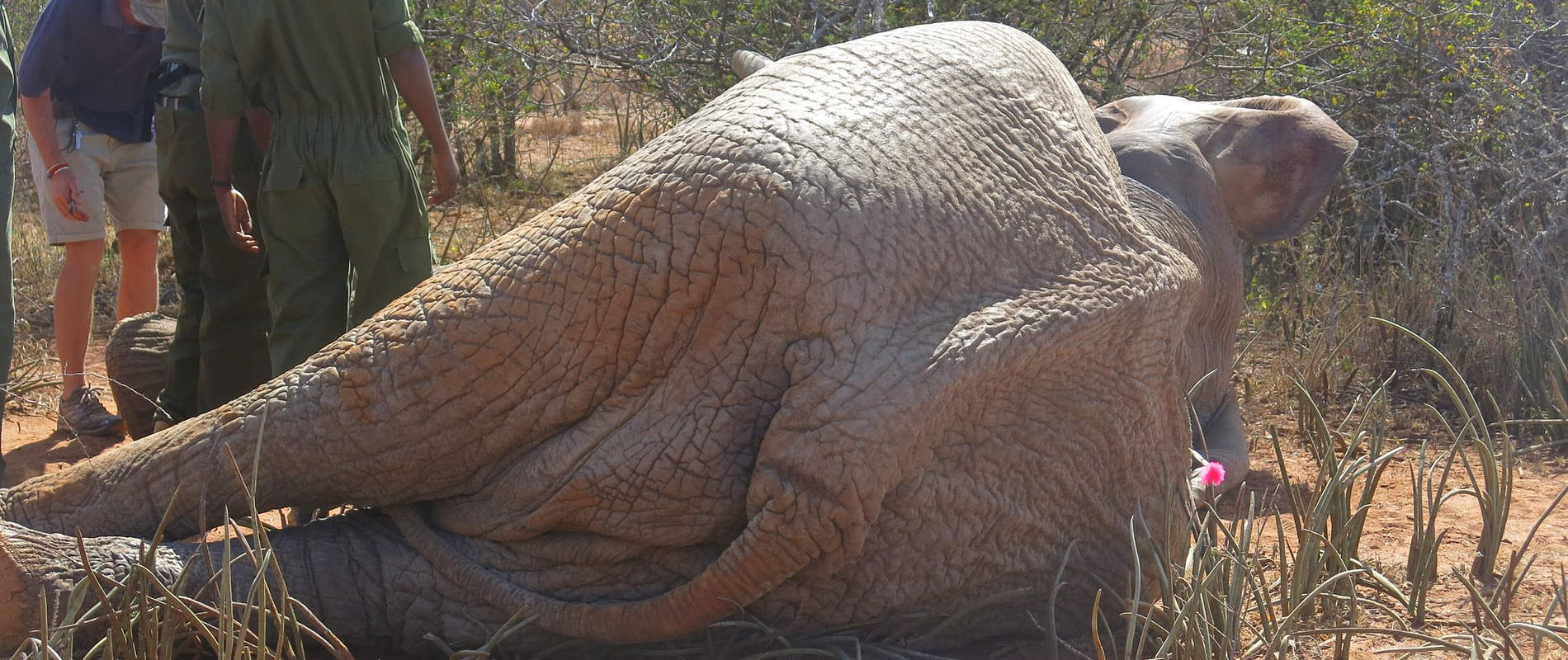EASTERN CONSERVATION AREA VETERINARY UNIT MONTHLY REPORT SEPTEMBER 2016 Report by: Bernard Rono Summary This report describes activities of the Meru Veterinary Unit in northern Kenya in September 2016
EASTERN CONSERVATION AREA VETERINARY UNIT MONTHLY REPORT SEPTEMBER 2016
Report by: Bernard Rono
Summary
This report describes activities of the Meru Veterinary Unit in northern Kenya in September 2016. Generally, dry weather conditions continued to affect many parts in northern Kenya causing reduced water sources and vegetation. This has led to increased interaction, in areas where pasture and water is available, between wildlife and communities living around these conservation areas.
The following activities were carried out during the month under review: a male white rhino was relocated to Solio wildlife sanctuary after it broke out through the fence. Three leopards which were involved in conflict with communities in central and northern Kenya were released in Meru National Park. In Lewa Conservancy an elephant which had a wire entangled around its legs was darted to remove the wire and a Grevy zebra carcass was examined to determine the cause of death. In Naibunga Conservancy an elephant was darted to investigate the cause of lameness.
We would like to acknowledge logistical and financial support provided by the David Sheldrick Wildlife Trust to enable timely veterinary intervention on affected wildlife in northern Kenya.
CASE #1: WHITE RHINO RELOCATION
Date: 8th September 2016
Species: White Rhino
Sex: Male
Age: Adult
Location: Solio ranch
Relocation
On 7th September, a male white rhino (WR) in Solio ranch was reported to have escaped out of the sanctuary into a nearby property (private airstrip) through a gap in the fence on an eroded river bed. There was serious concern about its security and it also posed a risk of injury to people since this airstrip bordered a public road. Attempts to drive back this rhino using a helicopter and vehicles were not successful.


On 8th September, it was captured and released into the sanctuary. A combination of Etorphine and Azaperone was delivered using the Dan-Inject darting system into the neck muscles from foot. Induction time was seven minutes with the rhino lying on lateral recumbency. Its respiration rate and temperature was monitored during the procedure.
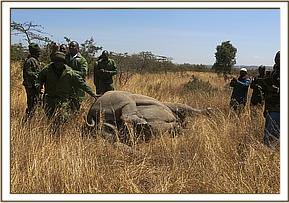

Reversal
Partial reversal of Etorphine was achieved by intravenous administration of M5050® and five minutes later the WR, which was in a standing position, was prodded into a customized transportation crate. In the crate, full reversal of anesthetic effect was achieved by intravenous administration of Naltrexone Hcl.


This WR was successfully released into the wildlife sanctuary and has since settled well in its territory.


We acknowledge KWS rangers in Solio who protected the rhino when it broke out of the sanctuary and assisted in the capture operation.
CASE #2: REMOVAL OF A SNARE
Date: 8th September 2016
Species: Elephant
Sex: Female
Age: Adult
Location: Lewa wildlife conservancy
History
An elephant was reported to have a loose wire entangled around its leg in Lewa Wildlife Conservancy. This elephant was in a group of 4 and was suspected to have picked the wire while attempting to break through a fence. It was immobilized to remove the snare before it caused further damage on its legs.
Immobilization and snare removal
Immobilization was achieved using M99® delivered in a DanInject darting system. This group of elephants were agitated and were darted from a vehicle after a brief chase. Down time was eight minutes with the elephant lying on right lateral recumbence.
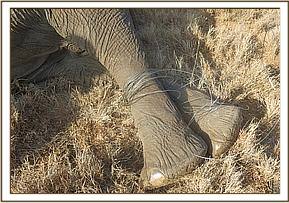

This loose snare was cut and removed from the legs.
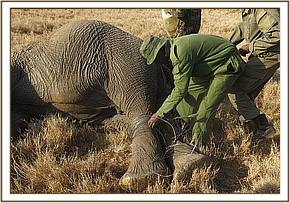

Reversal
The anesthetic effect was reversed by intravenous administration of M5050® through the superficial ear veins. This elephant was in standing position after three minutes and ran off to join the rest of the herd.
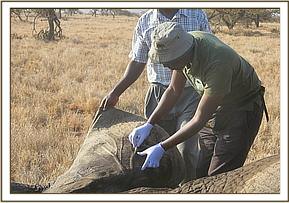

CASE #3: POST MORTEM EXAMINATION OF A GREVY ZEBRA
Date: 9th September 2016
Species: Grevy zebra
Sex: Female
Age: Adult
Location: Lewa wildlife conservancy
History
A Grevy zebra carcass in good body condition was found by rangers during routine patrol in Lewa Conservancy. A post mortem was conducted to investigate and document the cause of death.
This grevy zebra was found to have ruptured its colon with digested material in the abdominal cavity causing peritonitis. Rupture was suspected to have been caused by trauma.


CASE #4: LAMENESS IN ELEPHANT
Date: 18th September 2016
Species: Elephant
Sex: Male
Age: Adult
Location: Naibunga Conservancy
History
An elephant bull was reported to have shown lameness and swelling of its right forelimb in Naibunga Conservancy with minimal movement over the previous two days.
Immobilization, examination and treatment
Immobilization was achieved using Etorphine delivered using the Dan-Inject darting system from a helicopter with the elephant falling on left lateral recumbence after 10 minutes.


Examination showed a swelling of its right carpal; joint sprain was diagnosed. No other significant findings were seen. Anti-inflammatory drugs and antibiotics were administered intramuscularly. This elephant is expected to recover in the coming days.


Reversal
Complete reversal from anesthesia was achieved by intravenous administration of Diprenophine Hcl. Two minutes later the elephant was in a standing position.
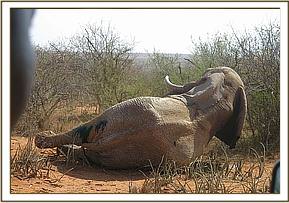

Prognosis
Good
CASE #5: LEOPARD RELEASE IN MERU NATIONAL PARK
Three leopards were released in Meru national park in September 2016. They were captured using cage traps by KWS problem animal control units in Gilgil, Kajiado and Biliqo Belesa conservancy. The leopards were reported to have caused livestock depredation and the relocation was aimed at rehabilitating them into new wildlife areas.
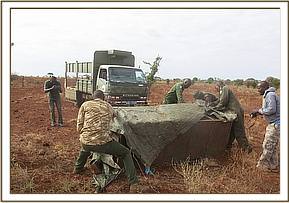

A suitable release site was selected at a central area within the park near a river with riparian vegetation providing cover for the leopards. Two leopards were initially quarantined in Nairobi KWS veterinary unit, physically examined and fitted with tracking collars to assist in post release monitoring. Data from the collars will provide useful information and guide management decisions.
